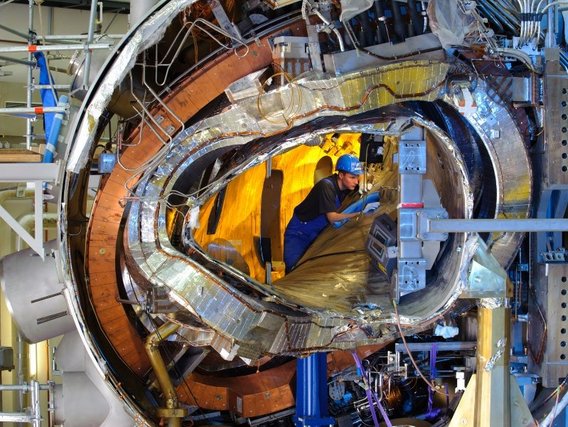Nuclear Fusion
Hotter than the sun
How Nuclear Fusion is Researched at the Wendelstein 7-X Experimental Facility.

Nuclear Fusion
How Nuclear Fusion is Researched at the Wendelstein 7-X Experimental Facility.

04 July 2024
Without the sun, our Earth would be barren and empty. Its life-giving light is produced in its hot interior – hydrogen atom nuclei fuse there to form helium. This nuclear fusion releases enormous energies that warm the solar system. At the experimental facility Wendelstein 7-X in Greifswald, experimental physicist Robert Wolf from the Max Planck Institute for Plasma Physics is working to make nuclear fusion a usable energy source on Earth.
Mr. Wolf, what advantages does nuclear fusion offer compared to nuclear fission?
Robert Wolf: Nuclear fusion offers two decisive advantages. Unlike nuclear fission, uranium is not required, which is limited in availability and must be extracted with great energy consumption. Instead, the fusion fuels are the hydrogen isotopes deuterium and tritium. Deuterium is found in seawater. Tritium – a radioactive gas – is scarcely found in nature, but it can be "bred" from lithium in the reactor. And lithium, which is primarily known from battery production, is also abundantly available on Earth. A fusion reactor requires extremely small amounts of fuel: for a power plant with a heat output of one gigawatt, it would be 300 grams of deuterium and lithium per day. A comparable coal power plant needs thousands of tons of coal daily, and a nuclear power plant requires several kilograms of uranium. Compared to the latter, a fusion power plant is also much "cleaner." Although the neutrons created during fusion also make materials in the reactor radioactive, they have a significantly shorter half-life. Steel, for example, used in the so-called plasma vessel – the heart of a fusion reactor – could be reused after 50 to 100 years. It would not need to be stored for the long term, unlike highly radioactive waste from nuclear power plants.
And what makes nuclear fusion so much more complicated than nuclear fission?
The principle of a fission reactor is relatively simple and can be compared to a kettle: The chain reaction of the fuel rods generates heat, which turns the water into steam; the steam is directed to a turbine, which generates electricity. In contrast, the real challenge with fusion is bringing about the fusion reaction itself. Atomic nuclei are positively charged and repel each other. They can only fuse if they come sufficiently close. In the sun, this is achieved by the enormous pressure, which we cannot technically reproduce – at least not in a continuously running reaction.

So how can fusion be achieved on Earth instead?
A fusion reactor requires temperatures that are about ten times hotter than the sun. At these temperatures, hydrogen gas turns into plasma. This means the atoms are broken apart, and electrons and atomic nuclei move independently of each other. The higher the temperature, the faster the atomic nuclei move, allowing them to overcome their repulsion and fuse. The goal is to heat the plasma to 100 million degrees to ignite it and trigger a self-sustaining fusion reaction. The reactor would thus generate more energy than is put into it. This is still not possible. The experimental reactor ITER, being built in France and involving the EU, Japan, China, Russia, South Korea, India, and the USA, is intended to generate a burning plasma that can produce energy for an extended period. However, it will not yet produce electricity. To achieve and maintain these high temperatures, the plasma must not lose heat too easily. Like a house wall, we need insulation. And this insulation is provided by a strong magnetic field at ITER, as well as in our experimental facility Wendelstein 7-X. It confines the plasma and prevents it from coming into contact with the wall of the plasma vessel, thus preventing contamination or cooling down.
What is the goal of your research at Wendelstein 7-X?
While reactors like ITER or the experimental facility JET in the United Kingdom use a Tokamak reactor, at Wendelstein 7-X, we are testing for the first time the theoretical concept of an optimized stellarator in practice. The stellarator is the older concept and, in principle, better suited for continuous operation and, thus, for power plant use. However, its magnetic field needs to be optimized, meaning it must be much more complexly designed and fine-tuned, which only became possible with advancements in physical knowledge and increasing computing power starting in the 1980s. With Wendelstein 7-X, we aim to gain important insights for power plant operation and specifically demonstrate that it is possible to maintain a high-temperature plasma with a stellarator for extended periods. In 2023, we succeeded in keeping a plasma at 20 million degrees for eight minutes.
What are the central challenges you are addressing in your research?
The design of the magnetic field in a stellarator is highly complex. A large part of the research revolves around the question: How should such a magnetic field be shaped to enclose the plasma as efficiently as possible while still being technically and economically feasible? At the same time, we are also working to understand more precisely how the plasma behaves in such a stellarator. Just as turbulence occurs in air or water, turbulence also forms in a plasma, creating swirls. These swirls cool down the plasma, which we naturally want to avoid as much as possible. Today’s supercomputers allow us to calculate these turbulences for the first time. And the deeper we understand how these turbulences behave, the better we can counteract them in the design of a fusion power plant.
What is the further roadmap for Wendelstein 7-X?
Our central goal is to gradually increase the duration of the experiment to 30 minutes and the plasma temperature to up to 50 million degrees. This is technically anything but trivial and cannot be done overnight. To heat the plasma, we use special high-performance microwave tubes, which only four companies in the world can manufacture. With these companies and other research institutions, we have launched a program to develop twice as powerful tubes for Wendelstein 7-X.
When can we expect the first fusion power plants to be in operation?
Fusion technology is something fundamentally new. And when you are doing things that have never been done before, failures are inevitable, and it often takes longer than originally predicted. ITER was supposed to generate its first plasma starting in 2025, but the completion has been delayed due to necessary repairs on delivered components. However, we can draw important lessons from these delays: So far, we are on a cautious path. This means that the development steps for the fusion reactor follow each other successively – and only once a new intermediate stage is reached does the next phase begin. If we instead accelerate the process, meaning working simultaneously on different solutions and investing more money into research and development, we could complete the first demonstration power plant much faster, perhaps even in 20 years. That may sound like a long time, but the global transition to climate-neutral energy production will not be completed by then. And nuclear fusion could be an important complement to renewables, as it would be able to provide energy-intensive industries, urban areas, and especially the growing number of megacities with CO2-free electricity and heat at all times of the day and in all weather conditions.
This is an article from #explore. #explore is a digital journey of discovery into a world that is rapidly changing. Increasing connectivity, innovative technologies, and all-encompassing digitalization are creating new things and turning the familiar upside down. However, this also brings dangers and risks: #explore shows a safe path through the connected world.